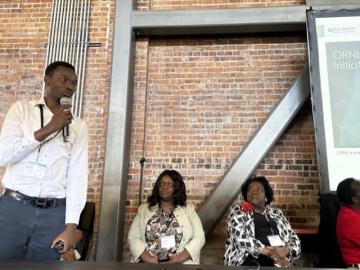
Filter News
Area of Research
- Advanced Manufacturing (2)
- Biological Systems (1)
- Biology and Environment (3)
- Energy Science (54)
- Fossil Energy (1)
- Fusion and Fission (2)
- Fusion Energy (2)
- Isotopes (2)
- Materials (45)
- National Security (4)
- Neutron Science (22)
- Nuclear Science and Technology (8)
- Supercomputing (29)
- Transportation Systems (1)
News Type
Date
News Topics
- 3-D Printing/Advanced Manufacturing (31)
- Advanced Reactors (5)
- Artificial Intelligence (45)
- Big Data (28)
- Bioenergy (17)
- Biology (22)
- Biomedical (13)
- Biotechnology (10)
- Buildings (29)
- Chemical Sciences (30)
- Clean Water (6)
- Composites (11)
- Computer Science (48)
- Critical Materials (10)
- Education (2)
- Emergency (3)
- Energy Storage (15)
- Environment (41)
- Exascale Computing (26)
- Fossil Energy (4)
- Frontier (21)
- Fusion (12)
- Grid (16)
- High-Performance Computing (45)
- Hydropower (1)
- Isotopes (17)
- ITER (2)
- Machine Learning (23)
- Materials (24)
- Materials Science (26)
- Mathematics (7)
- Mercury (2)
- Microelectronics (2)
- Microscopy (4)
- Molten Salt (1)
- Nanotechnology (2)
- National Security (34)
- Neutron Science (26)
- Nuclear Energy (15)
- Partnerships (29)
- Physics (9)
- Polymers (5)
- Quantum Computing (20)
- Quantum Science (22)
- Security (8)
- Simulation (24)
- Space Exploration (3)
- Statistics (3)
- Summit (14)
- Transportation (15)
Media Contacts

Maximiliano Ferrari, a researcher in the Grid Systems Architecture group at the Department of Energy’s Oak Ridge National Laboratory, has been elevated to prestigious senior membership in the Institute of Electrical and Electronics Engineers.

The National Center for Computational Sciences, located at the Department of Energy’s Oak Ridge National Laboratory, made a strong showing at computing conferences this fall. Staff from across the center participated in numerous workshops and invited speaking engagements.

ORNL’s National Security Sciences Directorate partnered with the University of Tennessee’s Howard H. Baker Jr. School of Public Policy and Public Affairs to develop a graduate certificate in nuclear security that launched in the fall of 2024.

ORNL researchers created and tested two methods for transforming coal into the scarce mineral graphite, which is used in batteries for electric vehicles.

Since their establishment in 2020, the five DOE National Quantum Information Science Research Centers have been expanding the frontier of what’s possible in quantum computing, communication, sensing and materials in ways that will advance basic science for energy, security, communication and logistics.

A research collaboration between the Department of Energy’s Oak Ridge National Laboratory and several partner institutions was honored with the Best Event Report award at the 2024 International Conference on Game Jams, Hackathons and Game Creation Events.

Researchers are using machine learning to provide a more complete picture of building geometries that include building height to within three meters of accuracy. This model not only provides building height for any building in the world, but it will also feed into LandScan and other large government datasets for planning and response.

Scientists and land managers interested in accessing the first dataset of its kind on one of the most biologically diverse ecosystems in the world were given hands-on tutorials during a recent workshop by researchers supporting the ORNL Distributed Active Archive Center for Biogeochemical Dynamics.

FREDA is a new tool being developed at ORNL that will accelerate the design and testing of next-generation fusion devices. It is the first tool of its kind to combine plasma and engineering modeling capabilities and utilize high performance computing resources.

The Department of Energy’s Oak Ridge National Laboratory had a major presence at this year’s International Conference for High Performance Computing, Networking, Storage, and Analysis (SC24).


